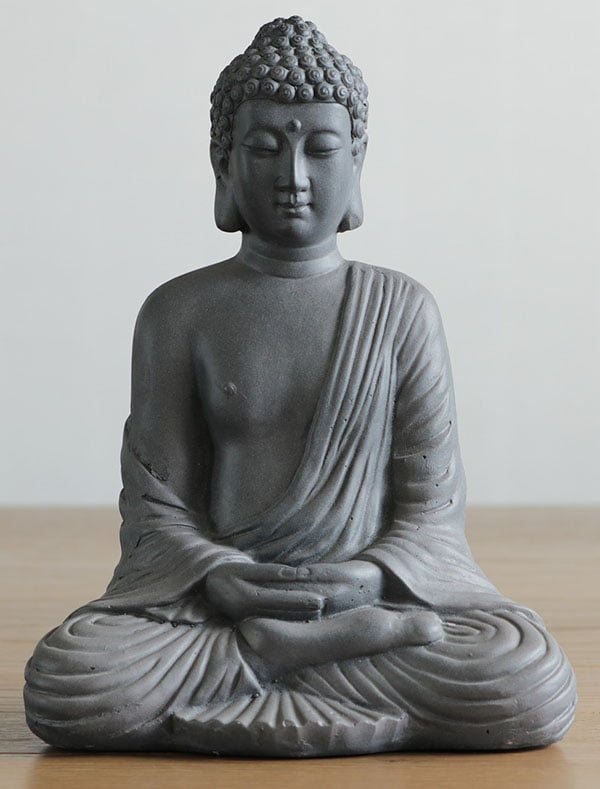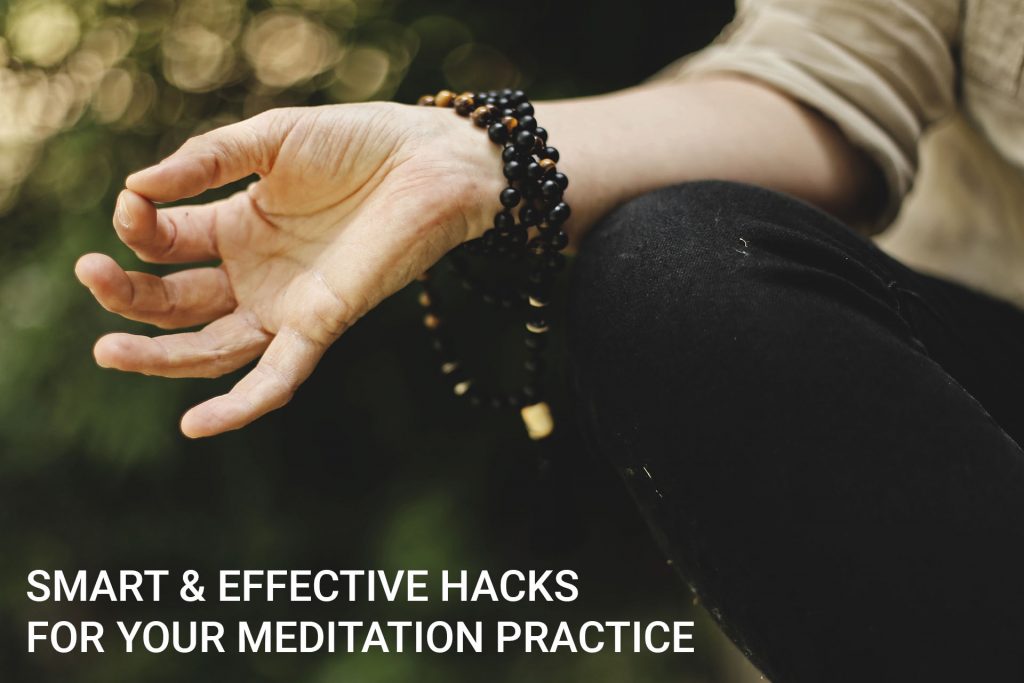Affiliate disclosure: Some of the links below are affiliate links, meaning, at no additional cost to you, I will earn a commission if you click through and make a purchase. As an Amazon Associate I earn from qualifying purchases.
10 most effective meditation hacks for lazy people (smart ways to eliminate all hindrances to improve your practice in 2023)
As you may have already known, meditation is actually easy to do. You can do it anywhere, anytime. Yet, a lot of people are struggling in their daily practice.
Try googling it in forums. Or, you can also ask around in the “offline world” amongst those who are practicing daily, maybe talk to your friends or to people you personally know.
Laziness, lack of interest and motivation are usually the case. I really understand these obstacles INTIMATELY. Believe me. I’ve struggled myself too, for years. Hahaha… 😄
In this post, I want to share with you the 10 effective meditation hacks that you can try to overcome those hindrances and to take your meditation practice to the next level.
Let me be honest with you.
I am quite a lazy and stubborn kind of person. And also, I get bored easily. So, rarely I can keep my interest in anything I’m doing long enough. But now, I really experience the benefits of the right meditation practice in my life. More on this later.
That’s why I’m sure that the tricks I’m going to share with you here will make sense and will definitely work to bring back interest and motivation into your daily practice.
I don’t want this post to be a lengthy article you don’t want to read. Because, in that case, it won’t be able to benefit others which is my intention in the first place.
Instead, I’ll focus on the HACKS.
As for other related aspects, I’ll simply link to other posts that I find well-researched and well-written. In case you feel the need to learn more.
If you want to head directly to the hacks, use the table of contents below to jump directly to the “Summarizing your effective meditation hacks” section.
Or, if you want to learn about all the thoughts and practical reasons behind those hacks, please, read on.
Table of Contents
Reexamine your understanding of meditation and choose the type that best suits you

First, let’s clear a few things up about meditation. Because, with the wrong notion, you won’t be able to maintain your interest and motivation.
I won’t talk at length about the definition of meditation. I’ve written about it in my free guide: “Mindfulness in Two Steps”. You can download it here.
My point is, you need to choose the kind of meditation that best suits you.
People are diverse in characters, psychological makeups, personality types, religious and cultural backgrounds, upbringings, etc. This is why in the 5,000+ years of the history of meditation, many types and techniques have been discovered to fulfill these various needs.
Or, in other words, there’s no “one size fits all” in meditation.
If you want to dig more about that many types of meditation, check this guide.
Now, let me tell you a little bit about my meditative journey. I’ll make it brief. If you want to learn the more complete version, check out my about page.
In short, I attended several meditation retreats and the ones that suit me very well is the Buddhist Vipassana with the cittānupassanā (the third Satipaṭṭhāna) tradition. Or in layman term: contemplation of the mind.
Ok, please understand, in my blog, I’m trying VERY-VERY HARD to avoid any technical and scriptural terms because I want my blog can benefit as wide an audience as possible regardless of religious and or spiritual backgrounds.
Many people believe that the ultimate goal of meditation is spirituality. I tend to agree with that. But, for me, spirituality is a long journey and it begins with EVERYDAY LIFE. For that reason, my emphasis is on this everyday life.

“The past is already gone, the future is not yet here. There’s only one moment for you to live, and that is the present moment.”
Buddha
Now, let’s get to the point.
My practice has been INCREDIBLY life-transforming for me.
I’m becoming less and less unhappy, less and less reactive, less and less complaining.
Finally, I begin to understand what natural acceptance of things as they really are is all about. The term my teacher was always preaching frequently in retreats. That natural acceptance is not the result of some intellectual reasoning. It’s the effect of the practice. It comes on its own without me expecting it.
Over time, I also notice, losing my center is becoming less often and recovering my balance is becoming quicker and more effortless.
When you get to this point, or when you’re starting to experience the real benefits of meditation in your life, it’s like you’re gaining momentum. Interest and motivation become less and less needed.
But, before you get to that point, hacks are needed for maintaining interest and motivation.
First, it begins with the type of meditation practice that suits you well.
I choose my type because for me, it’s easy to understand and practical to follow. I don’t need a specific object. Any natural objects can do, with the right attitude. Breathing is a good start because it’s natural and always with you.
See, I don’t need to choose objects. With the right attitude, any object is the right object.
What is the right attitude in meditation? Grab my eBook here.
What about meditation posture?
Basically, they are sitting, walking, lying down and daily activity.
Sitting posture is the most widely known for achieving a deeper level of meditative states. Having said that, beginner yogis often experience pains, aches, and other discomforts during longer sitting. That’s where smart meditation preparation comes in handy.
Usually, lying down is not recommended for beginners because of the susceptibility to falling asleep. But, in case you’re on bed rest, then, by all means.
Check my shockingly practical tips on how to stop falling asleep during meditation here!
Only one caveat though:
You need to maintain awareness continuously, without breaks. But, in case you do, gently bring back your awareness. No need for punishing yourself.
I don’t need to focus too hard or exerting too much energy. I can do it in a relaxed way. I just need to maintain awareness as continuously as I can, all day long.
As you can see, the approach is very gentle and makes sense.
“When the retreat is over and you’re going home, going back to your everyday life, think of it this way: You’re not returning home. You’re going to another retreat center!” is what my teacher always said on the last day of our retreats.
In short, for me, every moment is the time to practice.
It’s not just sitting on a cushion, cross-legged!
The bottom line?
Reexamine your understanding of meditation and choose the type that best suits you. They will directly affect your interest and motivation.
Reevaluate your goal of practicing meditation

What is your goal of practicing meditation?
I’ve talked to many friends and colleagues about the goal of practicing meditation. It ranges from many mundane goals like having career promotion, successful business endeavor, better health or stress management, relaxation, happiness, etc. to the more bizarre one like having psychic powers.
While having psychic powers through meditation is possible, it’s beyond the scope of my blog.
My point is, your goal will affect your ability to maintain interest and motivation.
Say, you set your goal like one of the above. Automatically, whether you’re realizing or not, you’re waiting for results to show up. When results aren’t showing up, not only it will dwindle your motivation, you’ll get depressed.
Nowadays, many benefits of meditation practice have been proven scientifically. Yes, but, those results will only come in due times. It’s nature at work. We cannot force it.
For example, this 2011 report presents a study of mindfulness meditation program conducted at the University of Massachusetts Center for Mindfulness. Using magnetic resonance (MR) images they found increased grey-matter density in the hippocampus, known to be important for learning and memory, and in structures associated with self-awareness, compassion, and introspection.
Using those benefits as your goal can be non-conducive for keeping your interest and motivation. Why? Because you’ll always be waiting for results to show up.
If you want to learn more about what meditation benefits are really backed by science, check this post.
So, choose your goal wisely.
What is the right goal then?
Well, to be honest, I cannot talk about other people. I can only talk about my experience, what works for me.
My goal is NO GOALS!
Yes, you read that right. No goals, at all.
My motivation to practice is simply ENJOYING THE PRACTICE!
With no goals, suddenly, a lot of burdens are lifted from my shoulders. I’m not waiting for any results to show up.
Maybe you find it hard to believe that such motivation of simply enjoying the practice can actually work? Remember what I said earlier? My practice is easy and practical. I can do it anywhere, anytime.
Then, after some time of practicing, you begin to experience positive results. Therefore, naturally, over time, you’ll need less and less motivation. Your practice will become more and more effortless.
You don’t need to believe me. It’s not a promise. It’s nature at work!
Maybe it’s time to reevaluate your goal?
Identify and neutralize the demotivating factors

Demotivating factors for meditation practices come in the form of distractions or hindrances. They can be grouped into the following categories:
- Sense-desire
Do you like beautiful sceneries? Beautiful flowers? Or, maybe the sweet aroma of freshly brewed coffee distracts you? - Ill-will, resentment, hostility, aversion, hatred
Are you angry at someone or something? Or, because things just don’t work out like you want them to be? - Laziness, lack of mental energy or motivation.
Something keeps telling you that it’s useless. It’s better to do something else, something more fun. As time goes by, your interest and motivation begin to dwindle. - Restlessness, worry, anxiety
Worries and anxious thoughts can take many forms. They’re all not uncommon in everyday life. And, you want to get rid of them, right? Is that the right attitude? - Skeptical doubt, perplexity, unsure feeling
You might be wondering why you keep practicing while you’re not experiencing any positive results? You begin to doubt whether you’re practicing the right way or is it worth keeping doing it?
How do you hack them?
As you probably have noticed, all the above obstacles are happening in the mind. They’re mental in nature. They happen to all of us. They are natural!
Neutralize them!
How?
By doing what skillful yogis do.
“But I’m not one,” you said. Well, just pretend to be one! 😄
Since they’re all mental phenomena, either thoughts, feelings, bodily sensations that trigger desire, etc., they are just your meditation object!
“Objects are where you pay your attention to, what to be aware of, without judgments.”
Chris Linard
You don’t cling to or love objects and you also don’t hate them!
Every time they happen, position them as the object. Keep reminding yourself this way. This is how you practice.
“But, what if I get carried away? What if I get lost in them?” you may ask.
Gently, immediately, go back to your initial object.
What is your initial object?
My initial object is simply breathing. I use breathing for my mindfulness practice as do a lot of other practitioners out there.
I know some people and a couple of friends use candlelight.
Pick one that suits you well. My tip is, choose one that’s emotionally neutral to you. This is important. Don’t choose something for your initial object simply because you like it. The reason is, it will drag you into the sense-desire trap in the first group above.
This technique is meant to strengthen your “awareness muscle” which is your foundation.
Ok, real example:
Let’s say you’re set to sit for 20 minutes.
Something in your mind is telling you, “20 minutes are way too long…”
How about 10 minutes? Still too long?
How about 5 minutes? Still, I can’t do it. The motivation level is at the lowest.
1 minute then. Can’t sit still for 60 seconds? Ok, I understand. I couldn’t either 😄.
How about only 1 breathing cycle?
It goes like this:
Try to keep your awareness for 1 breathing in, 1 breathing out and, repeat.
That’s it.
Breathe in, breathe out, repeat.
But remember, all being done while keeping awareness.

Photo by Elijah Hiett on Unsplash
This simple smart trick works for me all the time, flawlessly!
I use this technique for the hardest times to practice, whenever I feel the lowest point of motivation. An example of such is when I’m very tired. After the initial breathing, I can use the thought about that “tiredness”, the accompanying bodily sensations or the feelings of uneasiness as the object of my practice.
Keep in mind that the hardest times to practice, whenever you feel the lowest energy, interest, and motivation are actually the BEST times to practice. In times like this usually significant progress happens.
That means, if you avoid practicing in times like this, you really miss the golden opportunities.
You might want to check my post:
9 Most Practical Sitting Meditation Preparation Exercises to Eliminate Pains and Aches for Lazy People
Additionally, practice in short durations but do it often. You wouldn’t believe this simple idea can effectively neutralize laziness. I use this trick often in the past. Try 5-minute sessions. I believe you can easily “insert” this 5-minute schedule into your busy daily life.
You can start by practicing for 5 minutes in the morning before work, 5 minutes in the evening after work. Then, add 5 minutes before going to bed. Additionally, you can also add this short session after a coffee break, before a tea break, after a lunch break, etc.
See, how easier it is to slip in this short 5-minute practice in your busy daily schedule?
After getting hold of it, you can gradually increase the duration.
Yongey Mingyur Rinpoche, an accomplished meditation master and a famous author of best-selling books like
- The Joy of Living: Unlocking the Secret and Science of Happiness
- Joyful Wisdom: Embracing Change and Finding Freedom
explained it clearly in a funny way 😄. You’ll learn a lot. Definitely worth watching:
You may also want to check his other works.
As you can see, I elaborated a bit more heavily on this section because, from my experience, I think this is the core problem to overcome. All the effective hacks should be implemented for getting through these obstacles.
“In meditation, one develops an understanding of the Five Hindrances — how, when one of them is present, you investigate it, you understand it, you accept its presence and you learn how to deal with it. Sometimes you can just tell it to go away and it goes; sometimes you just have to allow it to be there till it wears out.”
Ajahn Sumedho
As for the motivating factors in the next section? It really is not much to elaborate on.
Find the motivating factors that make you tick

Motivating factors?
You really don’t need one. Seriously!
Mental clarity, calm emotion, stable state of mind are some of the benefits of meditation practice I talked about in my free guide “Mindfulness in Two Steps.”
It’s also an effective tool for stress management, overcoming anxiety, panic attacks, and depression.
This article comprehensively put together 76 science-backed benefits of meditation and mindfulness.
You may want to scan them over and find one, two or even several that make you tick.
But, seriously, the tricks I’m proposing here are more towards neutralizing the demotivating factors and distractions that are keeping you from practicing consistently.
At the core, mainly, those factors are laziness and lack of interest and motivation.
A fellow practitioner once told me not to rely on motivation because motivation is really unreliable! Instead, he told me to rely on something 100x stronger. What is that?
It’s your solid daily habit!
So, the hack would be: don’t rely on motivation, build a solid daily habit instead!
It’s quite funny, isn’t it? When we think we’re struggling because of a lack of motivation, it turns out we don’t need it.
I’m not saying that motivation is 100% useless. It just means that you need not rely on it solely. You still need some motivation to build a solid daily habit.
How to build a solid daily practicing habit? What’s the trick? Just apply the other hacks I laid out previously.
Summarizing your effective meditation hacks
Now, let’s give you a quick recap.
These are the simple hacks, the effective techniques you can use to push your meditation practice to the next level:
- Reexamine your understanding of meditation.
- Choose the meditation type that best suits you.
- Reevaluate your goal of practicing meditation (It should be no goals).
- Neutralize all the hindrances by positioning them as your object. Be aware of the object with the right attitude.
- If you get carried away, gently and immediately go back to your initial object. This way, you keep strengthening your awareness muscle, your foundation.
- For the hardest times, use one breathing cycle of mindfulness. Simply breathe in, breathe out, repeat. Don’t forget, all being done while keeping awareness. Remember that the hardest times to practice are actually the best times to practice. In times like this usually significant progress happens.
- Practice in short durations but do it frequently. This simple trick can defeat laziness effectively. You can start with 5-minute sessions and gradually increase the duration.
- Remind yourself about all the benefits that will come from your persistent effort. The ones that make you tick, the ones that you care about the most.
- Don’t rely on motivation. Build a solid daily habit instead. Because a habit is much-much stronger than motivation.
- Finally, after implementing the hacks above, you can simply enjoy your practice. This way, you’ll easily gain momentum; you’ll need less and less motivation.
I have to say, the hacks on the list work best as a whole, not individually.
Remember to practice consistently, anywhere, anytime.
The key takeaway and recommendation

If you can nullify the obstacles that keeping you from practicing consistently, your practice will become effortless. You will never need any more motivation. This way you will progress immensely.
This is what these hacks are all about. Eliminating the hindrances by DEPLETING THEIR POWERS over you.
If they work for a stubborn and lazy person who easily gets bored like me, I’m pretty sure they will also work for you.
If you feel the need to track your progress, advances in technology have given us a handy tool just for the task. You can try this headband.
If you have the time to attend a meditation retreat, go for it. The retreats I have attended were mostly 10 days in duration. Bear in mind, those were vipassana meditation retreats that in my opinion, for beginners, 10 days is merely an introduction.
As for other kinds of meditation, I really cannot say much. I know some that claim can bring results with just one session of practice. Sounds unbelievable? Well, you need to do your due diligence. Seriously. If it sounds too good to be true, it’s probably too good to be true.
But, in case you’re too busy and cannot allocate the time or have no easy access to suitable meditation retreats near your area, you can take the online meditation course by Giovanni Dienstmann.
- He has 9,000+ hours of meditation practice under his belt,
- has been practicing daily for the past 18 years,
- has tried 70+ different technique,
- has studied 200+ books on the topic,
- was formally initiated into 4 different meditation traditions,
- nearly became a monk, twice,
- wrote a best-selling book “Practical Meditation”, popularly been called “The Meditation Bible’, available in 7 different languages.
- He is a certified meditation teacher with Meditation Association of Australia (categories of “Personal Development Meditation” and “Spiritual Meditation”)
I’ve been following him for a while so I know he’s an accomplished practitioner and a qualified teacher. Right now his online course is the only one I recommend.
You can read my review here.
UPDATE 27 Feb 2020:
If you act fast, you may still get the 14-day trial for $1 offer. Because I guess the offer won’t be available for long.
Further readings
- During the Coronavirus Covid-19 Pandemic, What’s the Best Thing Meditators Can Do?
- The Most Effective Hack for Overcoming Fear of Failure Without Struggling
- The Most Effective Sleep Hacks for Lazy People
- Best Meditation Online Course for Lazy People
- How Can Mindfulness Meditation Help with Depression?
- How to Relieve Stress and Anxiety Naturally
- Who Can Really Help You Stop the Fear of Panic Attacks?
Featured Photo by Ksenia Makagonova on Unsplash
- Too Much Mindfulness, Is There Such a Thing? - March 17, 2022
- 10 Ways Meditation Can Help Improve Your Finance (Number 9 Might Surprise You!) - January 7, 2022
- Forget Self-Improvement, Do This Instead! - September 16, 2021
